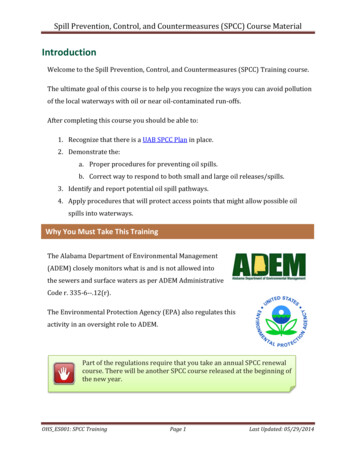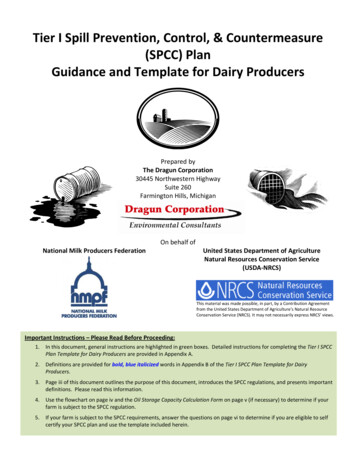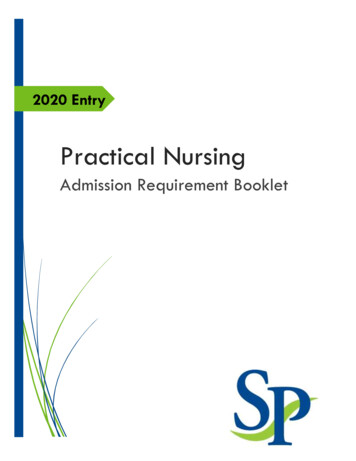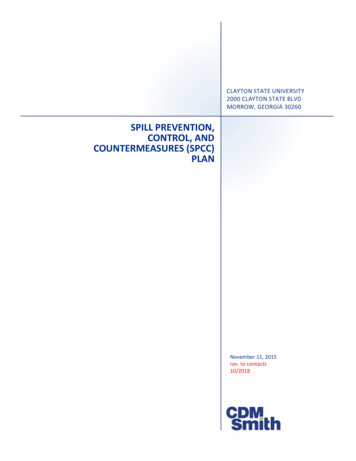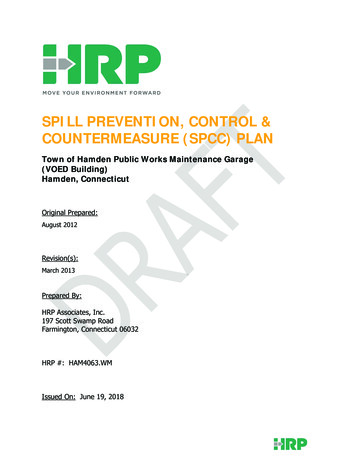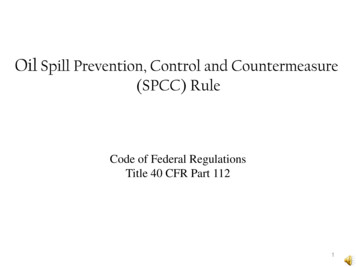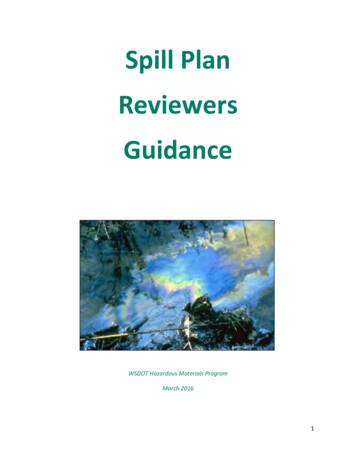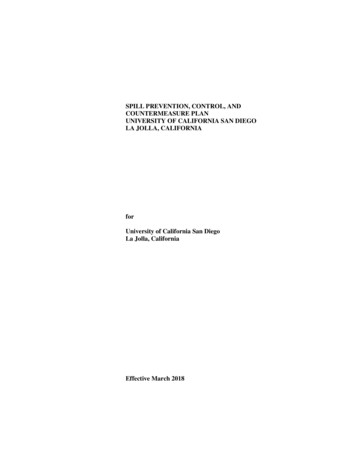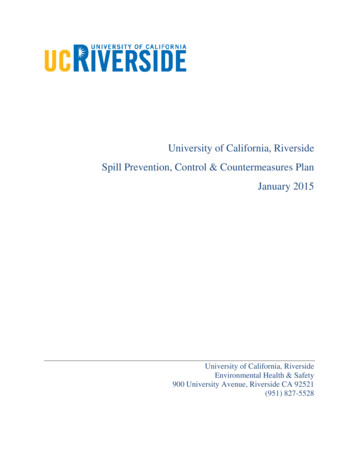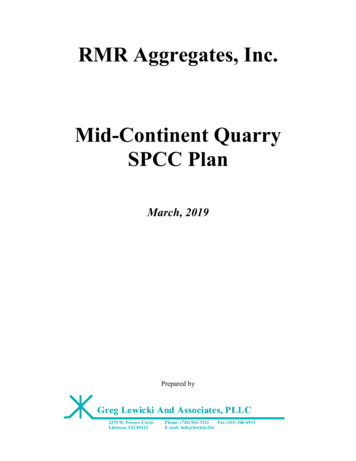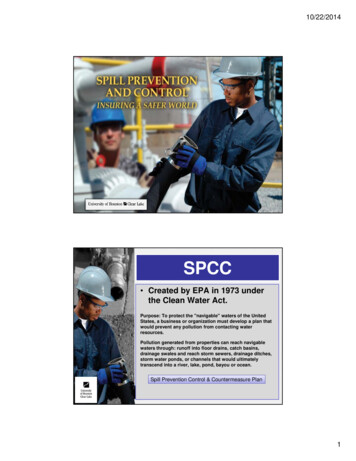
Transcription
Spill Prevention, Control, andCountermeasure (SPCC) PlanBenjamin Franklin BridgeBetsy Ross BridgeCommodore Barry BridgeWalt Whitman BridgeIn NJ and PABH No. 77397-01October 2021
TABLE OF CONTENTS1 INTRODUCTION . 71.1 Scope of SPCC Plan. 71.1.1 Amendments to the SPCC Plan - 40 CFR 112.5 . 92 FACILITY INFORMATION . 102.1 Benjamin Franklin Bridge . 102.2 Betsy Ross Bridge . 132.3 Commodore Barry Bridge . 132.4 Walt Whitman Bridge162.5 Spill Prevention Team Members . 182.6 Duties of the Pollution Prevention Team Members . 192.6.1 Duties of the Chief Operating Officer and Environmental Advisor. 192.6.2 Duties of the Maintenance Supervisor and Patrol Officer. 192.6.3 Duties of the Police Radio Dispatcher:. 203 SPILL PREVENTION, CONTROL AND COUNTERMEASURES PLANNING . 213.1 General. 213.2 Regulatory Requirements Review. 213.2.1 Oil Storage Tanks and Patterns of Use - 40 CFR 112.7(a) . 213.2.2 Potential Equipment Failure - 40 CFR 112.7(b). 233.2.3 Containment and Diversionary Structures - 40 CFR 112.7(c) . 243.2.4 Inspections and Records - 40 CFR 112.7(e) . 243.2.5 Personnel Training - 40 CFR 112.7(f). 253.2.6 Security - 40 CFR 112.7(g) . 253.2.7 Tank Truck Unloading - 40 CFR 112.7(h) . 253.2.8 Facility Drainage - 40 CFR 112.8(B . 263.2.9 Bulk Storage Containers - 40 CFR 112.8(b) . 273.2.10 Transfer Operations, Pumping and Facility Process- 40 CFR 112.8(d) . 27
APPENDIX ASEPARATE STORM AND COMBINED SEWER SYSTEM BOUNDARIESAPPENDIX BSUBSTANTIAL HARM DETERMINATION FORM; SPCC TEAM MEMBERS; PLAN REVIEW FORMAPPENDIX CEMPLOYEE TRAINING MATERIALSAPPENDIX DINSPECTION FORMS
LIST OF FIGURESTitlePageFigure 1 Benjamin Franklin Bridge maintenance facilities diagram12Figure 2 Betsy Ross Bridge maintenance facilities diagram14Figure 3 Commodore Barry Bridge maintenance facilities diagram15Figure 4 Walt Whitman Bridge maintenance facilities diagram17LIST OF TABLESTable3-1 Potential Equipment Failures23
LIST OF ACRONYMSASTAboveground Storage TankBFBBenjamin Franklin BridgeBMPBest Management PracticeBRBBetsy Ross BridgeCBBCommodore Barry BridgeCFRCode of Federal RegulationsCCMUACamden County Municipal Utilities AuthorityCOOChief Operating OfficerCWAClean Water ActDOTDepartment of TransportationDRPADelaware River Port AuthorityEPAEnvironmental Protection AgencyMOUMemorandum of UnderstandingMS4Municipal Separate Storm Sewer SystemNJDEPNew Jersey Department of Environmental ProtectionNPDESNational Pollutant Discharge Elimination SystemPADEPPennsylvania Department of Environmental ProtectionPOTWPublicly Owned Treatment WorksSPCCSpill Prevention Control and CountermeasuresSWMPStorm Water Management ProgramSWPPStorm Water Pollution PreventionUSTUnderground Storage TankWPCFWater Pollution Control FacilityWWBWalt Whitman Bridge
1 INTRODUCTIONThis document is a Spill Prevention Control and Countermeasures (SPCC) Plan for the Delaware River PortAuthority transportation facilities that meets the requirements of the Federal Oil Pollution Act (40 CFR 112).This plan is an update to the “REVISED DRAFT SPILL PREVENTION, CONTROL AND COUNTERMEASURE ANDSTORMWATER POLLUTION PLAN DATED MAY 2003 PREPARED BY WESTON SOLUTIONS, INC”. The source ofmaterial for this report update was taken from this document.The purpose of this plan is to minimize and abate hazards associated with oil products, which have thepotential to cause pollution of air, land, or water or endangerment of public health and safety through theiraccidental release. This document also satisfies requirements of New Jersey and Pennsylvania stateregulations, which require preparation of the Release Response Plan (N.J.A.C. 7:l4B) and Spill PreventionResponse Plan (PA Code §245.512).1.1 Scope of SPCC PlanThe SPCC Plan describes the actions to be taken to prevent the spill of oil and petroleum products. TheUnited States Environmental Protection Agency (U.S.EPA) regulations contained in Title 40 Codes of FederalRegulations Part 112 (40 CFR 112), require a Spill Prevention Control & Countermeasure (SPCC) Plan for anycommercial non-transportation facility storing an oil product which meets one or more of the followingconditions:1. The total aboveground storage capacity exceeds 1,320 gallons, with only containers withcapacity of 55 gallons and above accounted in the volume estimate;2. The underground storage capacity exceeds 42,000 gallons,3. Due to its location, the facility could reasonably be expected to discharge oil into or upon thenavigable waters of the United States, or adjoining shorelines or waters of the contiguous zone,or in connection with activities under the Outer Continental Shelf Lands Act or Deepwater PortAct, or affecting certain natural resources.Navigable waters are broadly defined under the Clean Water Act and Oil Pollution Act to include all watersthat are used in interstate or foreign commerce, all interstate waters including wetlands, and all intrastatewaters, such as lakes, rivers, streams, wetlands, sloughs, prairie potholes, wet meadows, playa lakes, ornatural ponds. Essentially, the term “navigable waters” refers to any natural surface water in the U.S. Nontransportation facilities are those not involved in bulk transport of oil products, as defined in Memorandum ofUnderstanding (MOU) of 1971 between USEPA and USDOT.7
The Delaware River Port Authority is subject to the SPCC requirements since the total aboveground storagecapacity exceeds 1,320 gallons at each bridge maintenance facilities. A spill from the tanks could be discharged tonavigable waters through an adjacent storm water collection system.The SPCC plan is not required to be filed with U.S. EPA, but must be certified by a registered professionalengineer. A working copy must be available for on-site review during normal office hours by U.S.EPA region II andNew Jersey Department of Environmental Protection (NJDEP) personnel or by U.S.EPA region III andPennsylvania Department of Environmental Protection (PADEP) personnel depending on the facility location.The SPCC plan must be submitted to the U.S. EPA Regions II and III administrators and the state agenciesalong with the other information specified in 40 CFR 112.4 if either of the following occurs:1. The facility discharges more than 1,000 gallons of oil into or upon the navigable waters of the UnitedStates or adjoining shorelines in a single event;2. The facility discharges more than 42 gallons of oil in each of two spill events within any twelvemonth period.A harmful quantity of oil is defined as an oil discharge that causes a film or sheen upon the water or adjoiningshorelines; discolors the water or adjoining shorelines; or causes an emulsion or sludge to be depositedbeneath the surface of the water or upon adjoining shorelines.If a spill event meets either of the above thresholds, then spill information must be reported to U.S.EPARegions II and III within 60 days. The report must contain the following information:1. Name of the facility;2. Name(s) of the owner or operator of the facility;3. Location of the facility;4. Maximum storage or handling capacity of the facility and normal daily throughput;5. Corrective action and countermeasures taken, including a description of equipment repairs andreplacements;6. An adequate description of the facility, including maps, flow diagrams, and topographical maps,as necessary;7. The cause of such discharge including a failure analysis of system or subsystem in which failureoccurred;8. Additional preventive measures taken or contemplated to minimize the possibility of recurrence;9. Such other information as the regional administrator may reasonably require that is pertinent tothe plan or spill event.8
The SPCC plan shall be amended within six months whenever there is a change in facility design,construction, operation, or maintenance that materially affects the facility’s spill potential.The plan must be reviewed at least once every five years and amended to include more effective prevention andcontrol technology, if such technology will significantly reduce the likelihood of a spill event and has beenproven in the field. All changes must be certified by a registered professional engineer.Owners and operators failing or refusing to comply with the SPCC regulations shall be subject to a civil penalty asspecified in Section 311(b)(6)(B) of the Clean Water Act, 33 U.S.C. §1 321(b)(6)(B).1.1.1 Amendments to the SPCC Plan - 40 CFR 112.5Once an SPCC plan has been developed, under certain circumstances it may be amended by the U.S.EPARegional Administrator or by the facility owner or operator. The regional Administrator may requireamendment to the plan following a single discharge at the facility in excess of 1000 gallons or following twodischarges in “harmful quantities” that occur within any twelve-month period and are reportable under theFederal Water Pollution Control Act.The SPCC regulations require the owner or operator to amend the SPCC plan whenever there is a change in facilitydesign, construction, operation or maintenance that materially affects the facility’s potential for discharging oilor hazardous materials. Such amendments shall be fully implemented not later than six months after suchchange occurs.The regulation also requires the owner or operator to review and evaluate the SPCC Plan every five years.Amending the plan may be part of this review. Within six months following the review, the owner or operatormay amend the plan to incorporate more effective control and prevention technology if the technology willsignificantly reduce the likelihood of a release, and the technology has been field proven at the time of thereview. All amendments must be certified by a registered professional engineer per Sec. 112.3(d) of the SPCCregulations.The DRPA personnel responsible for reviews of this SPCC Plan at five-year intervals are identified in AppendixB.9
2 FACILITY INFORMATIONThe following bridge facilities, owned and operated by DRPA, span the Delaware River and are located inPennsylvania (EPA Region III) and New Jersey (EPA Region II):1. Benjamin Franklin Bridge (BFB)2. Betsy Ross Bridge (BRB)3. Commodore Barry Bridge (CBB)4. Walt Whitman Bridge (WWB)Maintenance facilities for the BFB, BRB, and CBB are located in New Jersey and are regulated by NJDEP. Themaintenance facility for the WWB is located in Pennsylvania and is under the jurisdiction of PADEP. This SPCCPlan describes the BMPs that are employed at all facilities to reduce the potential for pollution of surfacewaters.2.1 Benjamin Franklin BridgeThe Benjamin Franklin Bridge is the oldest bridge owned by the DRPA and construction was started in 1922.The bridge was placed into operation in 1926. It spans the Delaware River from Florist Street in Philadelphia,Pennsylvania to Birch Street in Camden, New Jersey. The toll plaza, maintenance area and materials storageare all on the New Jersey side of the bridge and therefore are under the jurisdiction of the NJDEP. The DRPAdoes not own contiguous property beyond the ends of the bridge, but owns several properties used formaintenance of the bridge and associated vehicles as well as PATCO rail maintenance yard used foremergency repairs in the immediate vicinity of the New Jersey end of the bridge. Figures 1A and 1B presentsa site map of the Benjamin Franklin Bridge maintenance facilities. The main maintenance building is locatedat the intersection of the 5th and Elm Street, and the approximate coordinates are 39 56’ 53” Latitude, and75 07’ 18” Longitude. A map of the entire bridge span is included as Figure A-1 in Appendix A.10
11
12
2.2 Betsy Ross BridgeThe construction of the Betsy Ross Bridge began in 1969 and the bridge was placed in operation in 1976. Itspans the Delaware River from Route 95 in Philadelphia, Pennsylvania to Route 130 in Pennsauken, NewJersey. The toll plaza, maintenance area and materials storage are all on the New Jersey side of the bridgeand therefore are under the jurisdiction of the NJDEP. Figure 2 shows the site layout of the Betsy Ross Bridgetoll plaza and maintenance facilities. Maintenance facility’s approximate coordinates are 39 58’ 37” Latitude,and 75 02’ 57” Longitude.2.3 Commodore Barry BridgeConstruction began on the Commodore Barry Bridge in 1969 and the bridge was placed in operation in 1974.The Commodore Barry Bridge spans the Delaware River from Law Street in the City of Chester, Pennsylvaniato Bridgeport, New Jersey. The toll plaza, maintenance area and materials storage are all on the New Jerseyside of the bridge and therefore are regulated by the NJDEP. The Commodore Barry Bridge toll plaza is similarto those for the three other bridges that are described in this report. The DRPA owns the Route 322 corridorin New Jersey from the bridge to Route 130. Figure 3 shows the Commodore Barry Bridge toll plaza andmaintenance facility layout. The approximate coordinates of the maintenance facility are 39 48’ 32”Latitude, and 75 21’ 10” Longitude.13
14
LOGAN TOWNSHIP, GLOUCESTER COUNTY, N.J.15
2.4 Walt Whitman BridgeThe construction of the Walt Whitman Bridge began in 1953. The bridge was placed into operation in 1957. Itcarries Interstate Route 76 across the Delaware River just north of the Philadelphia Naval Shipyard in SouthPhiladelphia to just north of Gloucester City, New Jersey. The toll plaza, maintenance area and materialsstorage are all on the Pennsylvania side of the bridge and therefore would be regulated by PADEP. Figure 4shows the site layout of the Walt Whitman Bridge toll plaza and maintenance facilities. The DRPA owns theInterstate Route 76 corridor for a distance of approximately 6 miles west of the toll plaza. The approximatecoordinates of the maintenance facility are 39 54’ 37” Latitude, and 75 09’ 16” Longitude.16
17
2.5 Spill Prevention Team MembersPersons holding the following positions are responsible for the authorization and implementation of thisSPCC Plan. Individuals and contact numbers are located in Appendix B, where they can be updated withoutrecertification of this plan.Facility Name:Benjamin Franklin BridgeBetsy Ross BridgeCommodore Barry BridgeWalt Whitman BridgeMailing Address:One Port Center, 2 Riverside Drive, P.0. Box 1949, Camden, NJ 08101-1949Owner:Delaware River Port AuthorityDesignated Person Responsible for Reviewing, Approving, and Authorizing Corporate Resources forPrevention of Oil Spills and Storm Water Pollution:Chief Operating Officer (COO)Other Personnel Responsible for Implementing the Program to Prevent Oil Spills and Storm WaterPollution:Environmental AdvisorBridge DirectorPersonnel Responsible for Performing Routine Inspections of the Facility to Detect Oil Spills and StormWater Pollution:Maintenance Supervisor (if spill occurs in the facility)Patrol Officer (if spill occurs on the highway)Personnel Responsible for Initiating Response to Oil Spills and Storm Water Pollution:Maintenance Supervisor (if spill occurs in the facility)Patrol Officer (if spill occurs on the highway)Personnel Responsible for Coordinating Immediate Response to Oil Spills and Storm Water Pollution:Dispatcher18
2.6 Duties of the Pollution Prevention Team MembersThe DRPA Chief Operating Officer, Environmental Advisor, Maintenance Supervisors, Patrol Officers, andDispatcher are the core members of the team. Maintenance Supervisors are encouraged to assign additionalsite members to the team as part of their employee involvement initiatives. All of the employees working atthe maintenance facilities will receive training concerning pollution prevention BMPs and emergencyreporting procedures.2.6.1 Duties of the Chief Operating Officer and Environmental AdvisorThe Chief Operating Officer shall ensure that there are adequate corporate resources for the prevention,control and countermeasures of oil spills. They shall review and approve the SPCC plan every 5 years andwhen there are revisions to the plan.The Environmental Advisor serves as an information resource guide to assist with environmental regulatoryissues. His/her responsibilities include:a) Ensuring the facility SPCC and SWPP Plan is complete and up to date according to environmentalregulations.b) Preparing and submitting any written follow-up reports required by government agencies after a spillor release and for reporting the release to senior management.c) Reviewing and updating the document whenever there is a change in facility design, construction,operation or maintenance.d) Oversight of the implementation of SPCC and SWPP Plan.e) Follow up to the incidents and, with the NJDEP and/or PADEP approval, provide for treating, storingor disposing of residues, contaminated soil, etc., from a discharge, fire or explosion at the facility.2.6.2 Duties of the Maintenance Supervisor and Patrol OfficerMaintenance Supervisors and Patrol Officers are ultimately responsible for the execution of tasks outlined inthe Plan. They serve as 1st responders to imminent or actual emergency situations. The MaintenanceSupervisor is also accountable for the prevention of spills and leaks at the facility that could adversely impactsurface water or ground water. The term Maintenance Supervisor is used generally to refer to the DRPAmanager or other person with overall responsibility for the day-to-day operation of the maintenance facility.The term Patrol Officer refers to the police servicing DRPA bridges. The Maintenance Supervisor isresponsible for ensuring that:a) The Plan is implemented, maintained and amended as necessary.19
b) Appropriate measures and controls are implemented and maintained.c) Periodic inspections are conducted.d) Corrective or follow-up actions are completed in a timely manner.e) Whenever there is a significant spill or release, fire or explosion, he must immediately identify thecharacter, exact source, amount, and extent of emitted or discharged materials. This may be done byobservation, review of records or if necessary by chemical analysis. The Dispatcher is to be contactedimmediately with information above.f)Measures must be taken to ensure that fire, explosion, emission or discharge does not reoccur orspread to other materials. Measures include stopping facility activities, collecting and containingreleased materials or wastes, and removing or isolating containers.g) Significant releases are reported to the appropriate government agencies.h) Employees are periodically trained on Pollution Prevention.Patrol Officer responsibilities include:a) Maintaining spill supplies in the patrol vehicle.b) Responding to highway accidents and inspecting for possible fuel/oil release.c) If conditions allow, applying spill kit materials to prevent fuel/oil from reaching storm water systemd) Contacting dispatcher in case of the significant spill2.6.3 Duties of the Police Radio Dispatcher:The Dispatcher serves as the coordinator of response from various authorities. Dispatcher’s responsibilitiesinclude:a) Activation of facility communication systems, where applicable, to notify facility personnel.b) Assessment of any possible hazards to human health or the environment that may result from asignificant spill or discharge, fire or explosion,c) Coordinating emergency regime of work or stopping facility activities, if necessary.d) Contacting proper emergency authorities if incident exceeds ability of DRPA emergency services torespond.e) Contacting a local spill response contractor as necessary.f)Contacting National Response Center.20
3 SPILL PREVENTION, CONTROL AND COUNTERMEASURES PLANNING3.1 GeneralAs previously noted, the facilities are to be evaluated for the potential of oil products to be discharged intonavigable waters of the United States. This section of the document addresses spill prevention, control andcountermeasures planning at all bridge facilities as specified in 40 CFR 112.3.2 Regulatory Requirements ReviewThis portion of the Plan prepared in, accordance with the requirements of 40 CFR 112.7. The sections belowdiscuss oil storage and spill prevention at the facilities. Contact numbers, checklist of emergency procedures,logs of inspections and personnel training are attached in Appendices B, C, and D.3.2.1 Oil Storage Tanks and Patterns of Use - 40 CFR 112.7(a)This section describes oil containers and their usage at each facility (as shown on Figures 2-1 through 2-4).Emergency procedures and contact numbers are located in Appendix C.Benjamin Franklin BridgeThere is a large maintenance facility located on the South side of Elm Street between Fourth and FifthStreets. Operations within this facility include a vehicle maintenance shop. Floor drains in the vehiclemaintenance area drain to the City of Camden combined sewer system. These floor drains are equipped withoil-water separators that are cleaned once every two years. The maintenance facility is equipped with six (6)325-gallon storage tanks containing 15W-40, 5W- 20, 5W-30 and waste oil, transmission fluid, and hydraulicfluid. A 9,800-gallon aboveground gas/diesel fuel tank is located near Fifth Street. This tank has capacity for6,800 gallons of gasoline and 3,000 gallons of diesel fuel. The fuel island is located on the side of themaintenance building near Fifth Street. The fuel island has overhead protection and is situated on a concretepad to prevent storm water run-on. All storm water drainage from this parking lot flows into the City ofCamden combined sewer system. Two additional aboveground storage tanks contain diesel fuel foremergency generators. On the west side of the maintenance building is a 750-gallon tank is a double-walledsteel construction encased in concrete. At the Camden anchorage, on the ground level west side is a 750gallon tank is a double-walled steel construction. Bridge and toll plaza surfaces are cleaned with scrubbingmachines. Wastewater from this operation is stored in 1,000- gallon tank until hazardous materials removalcontractor transfers it to Camden wastewater plant.Other operations located in the same building include a paint room, machine shop, break rooms and lockerrooms, police facilities including a holding cell, and materials storage. All drains inside the building thatconnect to storm sewers have been sealed.21
Betsy Ross BridgeAn office/maintenance building complex is located to the northeast of the toll plaza. There is a motor vehiclefuel depot just outside of the maintenance building. An 8,800-gallon aboveground fuel tank supplies two fuelpumps. It is divided into two compartments with capacity for 6,100 gallons of gasoline and 2,700 gallons ofdiesel fuel. The fuel pumps are located under a shelter and are placed on a raised concrete pad to preventstorm water run-on. An additional aboveground storage tank contains diesel fuel for the emergencygenerator. It is located east side of the administration building and is a 1,700 gallon tank double-walled steelconstruction.Operations within the maintenance facility include a vehicle maintenance shop. Floor drains in the vehiclemaintenance area drain to the sanitary wastewater treatment system. These floor drains are not equippedwith oil — water separators. Fluids are stored in six (6) 325-gallon storage tanks containing 15W-40, SW-20,SW-30 and waste oil, transmission fluid, and hydraulic fluid.Commodore Barry BridgeAn office/maintenance building complex is located to the east of the toll plaza. There is a motor vehicle fueldepot just outside of the maintenance building. A 8,800-gallon aboveground fuel tank supplies two fuelpumps. It is divided into two compartments with capacity for 6,100 gallons of gasoline and 2,700 gallons ofdiesel fuel. The fuel pumps are located under a shelter and are raised on a concrete pad to prevent stormwater run-on. An additional aboveground storage tank contains diesel fuel for the emergency generator. It islocated south side of the administration building and is a 750-gallon tank double-walled steel construction.The maintenance shop stores motor oil, transmission fluid and hydraulic fluid in six (6) 325- gallon tankslocated inside the building. Antifreeze is stored in one-gallon containers. Floor drains within the maintenanceshop were closed off in 1993. These floor drains have been reopened and now drain to a 380-gallon holdingtank that is emptied by hazardous waste contractor as needed. Sanitary sewage drains to an on-site septicsystem.Walt Whitman BridgeThe maintenance facility at the Walt Whitman Bridge is very similar to the one at the Benjamin FranklinBridge in its operation. All drains inside the maintenance building flow to the City of Philadelphia sanitarysystem. There are three oil-water separators at this facility. All inlets in the parking lot discharge to the City ofPhiladelphia combined sewer system. Motor oil, waste oil, hydraulic fluid, and transmission fluid are stored insix (6) 325-ga1lon tanks inside the shop.In April 1993, the DRPA installed a dual compartment aboveground storage tank (AST). The tank is doublewalled steel construction. The outer wall of the tank is coated with concrete. The compartments are 3,00022
gallons used to store diesel fuel, and 9,000 gallons to store gasoline. Underground storage tanks, used priorto 1993, have been removed. All necessary remediation due to soil contamination was performed.Two additional aboveground storage tanks contain diesel fuel for emergency generators. The maintenancegenerator located at the rear of the maintenance yard is a 2,400-gallon tank double-walled steel constructionand inside the New Jersey anchorage is a 380 -gallon tank is constructed of double-walled steel. All of theASTs at the facility are registered with PADEP under number 51-45258.3.2.2 Potential Equipment Failure - 40 CFR 112.7(b)Potential equipment failure scenarios are described in Table 3-1.Table 3-1 Potential Equipment FailuresPotential EventComplete failure of maintenance shopfluids storage tank with secondarycontainment intact.Complete failure of maintenance shopfluids storage tank with complete failureof secondary containment.Complete failure of maintenance shopfluids storage tank with partial failure ofsecondary containment.Complete failure of aboveground storagetank (BFB, BRB, CBB) with secondarycontainment intact.Spill DirectionInside the secondarycontainmentInside the maintenanceshopInside the maintenanceshopInside secondarycontainmentComplete failure of aboveground storagetank (BFB, BRB, CBB) with completeOn to paved surfacesfailure of secondary containment.Complete failure of aboveground storagetank (BFB, BRB, CBB) with partial failureOn to paved surfacesof secondary containment.23VolumeReleasedSpill Rate0 gallonsInstantaneousUp to 325 gallonsInstantaneousUp to325 gallons0 gallonsUp to 3,000 or6,800 gallonsGradual toinstantaneousInstantaneousInstantaneousUp to 3,000 orGradual to6,800 gallonsinstantaneous
VolumeReleasedSpill Rate0 gallonsInstantaneousWest, towards theUp to 3,000 orGradual tomaintenance building9,000 gallonsInstantaneousWest, towards theUp to 3,000 orGradual tomaintenance building9,000 gallonsinstantaneousPotential EventSpill DirectionComplete failure of aboveground storageInside secondarytank (WWB) with secondary containmentcontainmentintact.Complete failure of aboveground storagetank (WWB) with complete failure ofsecondary containment.Complete failure of aboveground storagetank (WWB) with partial failure ofsecondary containment.3.2.3 Containment and Diversionary Structures - 40 CFR 112.7(c)The facility has the following containment and diversionary structures and response equipment:1. Each maintenance facility is equipped with sorbent
1.1 Scope of SPCC Plan The SPCC Plan describes the actions to be taken to prevent the spill of oil and petroleum products. The United States Environmental Protection Agency (U.S.EPA) regulations contained in Title 40 Codes of Federal Regulations Part 112 (40 CFR 112), require a Spill Prevention Control & Countermeasure (SPCC) Plan for any
